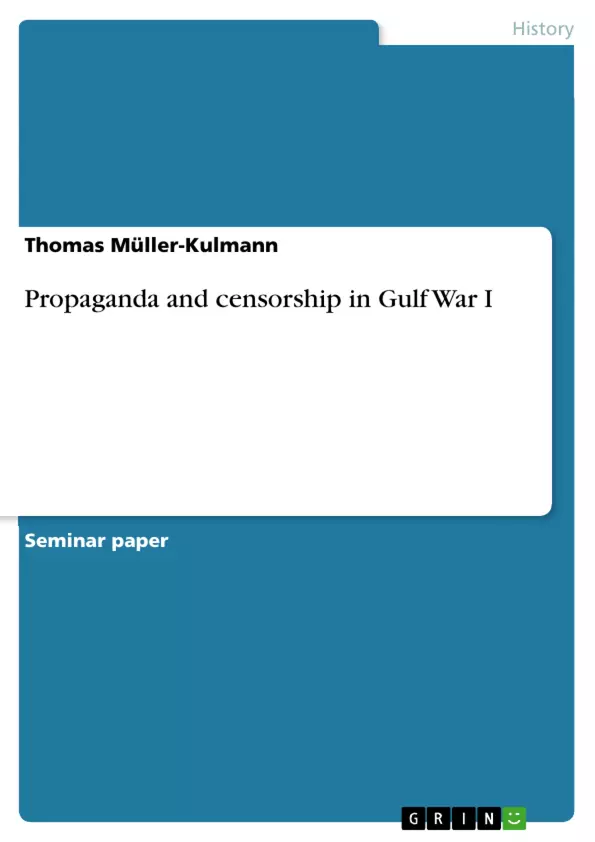“The Bush Administration achieved a five-month-long commercial for militarism and individual weapon systems. The American people were seduced into the celebration of a slaughter by controlled propaganda demonizing Iraq, assuring the world no harm would come to Iraqi civilians, deliberately spreading false stories of atrocities including chemical warfare threats, deaths of incubator babies and threats to the entire region by a new Hitler” (Initial Complaint of the International War Crimes Tribunal)1
The Persian Gulf War in 1991 is considered to be one of the most strongly censored wars in American history. Besides security reasons, the censorship policy was also intended to raise and sustain support for the American troops on the home front in order to avoid “mistakes” in the handling of the media, that supposedly lead to the defeat in the Vietnam War. Besides the restrictions for free media reporting inflicted by the government, the media was one of the strongest censors themselves. This paper deals with the censorship system that was used by the US military and the media’s self-imposed censorship. It addresses the question to what extent the system exceeded the intended security purpose and how the media reacted to those restrictions. Propaganda strategies used before and during the war are also being examined. Besides, emphasis is put on the media’s role as an independent institution and its performance to provide the American people with unbiased and relevant information.
Table of Contents
- Introduction
- Promoting War
- Propaganda for the liberation of Kuwait
- Kuwait's engagement in the propaganda
- Media's support for the war plans
- Censorship in the Gulf War
- Avoiding the Vietnam Syndrome
- The Pool System
- The Military Ground Rules
- Reporting under the government's restrictions
- "Unilateral" Reporting
- The Briefings
- Image vs. Reality
- Conclusion
Objectives and Key Themes
This paper examines the censorship system utilized by the US military and the media's self-imposed censorship during the Persian Gulf War in 1991. It explores the extent to which this system surpassed its intended security purpose and analyzes the media's response to these limitations. The paper also delves into propaganda strategies employed before and during the war, focusing on the media's role as an independent institution and its effectiveness in providing unbiased and relevant information to the American public.
- Censorship in the Persian Gulf War
- Propaganda strategies before and during the war
- The media's role as an independent institution
- Media's reaction to government restrictions
- The impact of censorship on public perception
Chapter Summaries
The introduction sets the stage by highlighting the significance of the Persian Gulf War as a heavily censored conflict. It points to the government's intention to prevent a repeat of the media's perceived role in the Vietnam War's defeat. The chapter "Promoting War" explores the propaganda campaign aimed at justifying the liberation of Kuwait. It examines the role of the Citizens for a Free Kuwait (CFK) and their collaboration with public relations firms, particularly Hill and Knowlton, in shaping public opinion. The chapter also discusses Kuwait's image problem and the efforts to portray Saddam Hussein as a threat akin to Hitler.
Keywords
The central themes of this paper revolve around censorship, propaganda, media, and the Persian Gulf War. Key concepts include the Vietnam Syndrome, the Pool System, government restrictions, media self-censorship, and the portrayal of Saddam Hussein as a threat. Additionally, the paper explores the role of public relations firms, such as Hill and Knowlton, in shaping public perception and the influence of oil interests on American foreign policy.
- Citar trabajo
- Thomas Müller-Kulmann (Autor), 2003, Propaganda and censorship in Gulf War I, Múnich, GRIN Verlag, https://www.grin.com/document/13504



